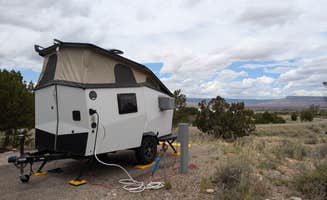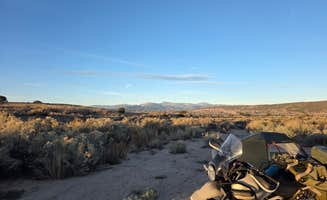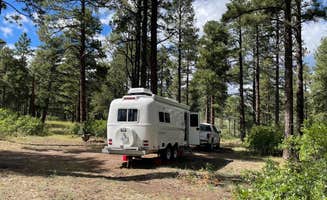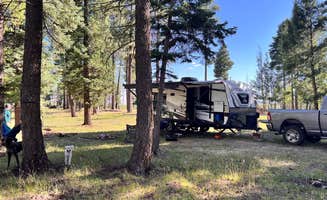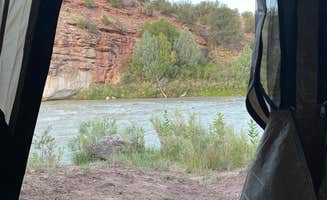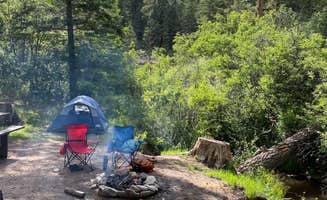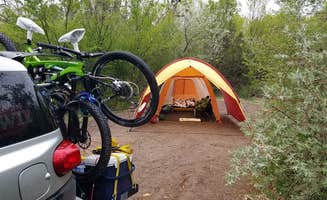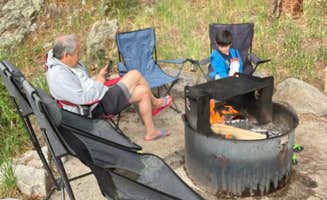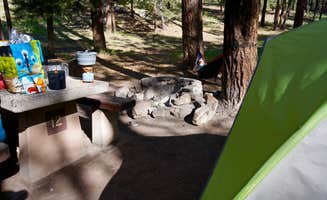Dispersed camping options near Vallecitos, New Mexico stretch across the Carson National Forest at elevations ranging from 7,000 to 10,000 feet. The mountain climate creates distinct camping seasons with summer temperatures averaging 75°F during days and dropping to 40°F at night. Higher elevation campsites receive up to 25 inches of snow from December through March, with dirt access roads becoming impassable without four-wheel drive.
What to do
Hike to waterfall overlooks: The trails near Jemez Falls Campground offer multiple hiking opportunities. "There are pit toilets only, and water fill stations for personal use, not camper fills. Dogs are ok with leash," notes one visitor. Several hiking paths lead through the ponderosa forest with the main attraction being the Jemez waterfall trail.
Mountain biking through burn zones: The forest service roads near Los Alamos provide technical riding with views of past fire recovery. "Lots of hiking trails, with proximity to attractions like Ghost Ranch, Bandelier National Monument, and Georgia O'Keeffe country adding cultural interest to outdoor recreation," explains a camper who stayed at Pajarito Springs. Mountain bikes are welcome on most trails, with some routes featuring challenging terrain.
Soak in mineral springs: Ojo Caliente Mineral Springs Resort & Spa offers thermal pools within walking distance of their campground. "They offer steam rooms, a multitude of pools of varying temperature and mineral content, in addition to a mud bath, lap swimming pool and full locker/ changing room," explains one camper. Morning hours (7:30-10am) provide the most peaceful soaking experience with fewer visitors.
What campers like
Mixed forest shade coverage: Vallecitos area campsites feature varying tree density. "Sites are nicely spaced apart with tons of trees for shade. Hiking trails lead into forest from various points," wrote a visitor to Jemez Falls. This natural canopy helps moderate summer temperatures, especially at higher elevation sites where afternoon thunderstorms are common.
Archaeological explorations: Proximity to Native American ruins adds cultural interest to camping trips. A visitor to Juniper Family Campground shared, "We stayed here for a week and a half in the middle of June 2019... there is GREAT accessibility to two of the truly most popular trails in NM. Behind campsite 28 is a short(0.4 mile) trail that leads to Trail 137." These connections to historical sites enhance the camping experience.
Seasonal wildflower displays: Spring and monsoon periods trigger vibrant wildflower blooms around campsites. "I also went on a hike at Los Conchas Trail maybe 10 minutes up the road (away from Jemez Springs) and was shocked by the beauty!! What a wonderful hike!" reported a camper who stayed at Dispersed on 4. The combination of elevation and precipitation creates diverse plant communities.
What you should know
Strict alcohol restrictions: Several campgrounds enforce no-alcohol policies with regular patrols. "We stayed in site # #9 for 5 nights with the National park pass it was $40.00 with water & electric & a view of the lake. The best site is #1. There is NO alcohol allowed in the park so don't get caught with any they will pour it out," warns a camper from Riana - Abiquiu Lake.
Seasonal road closures: Winter and early spring conditions limit access to many campsites. "As you enter go to the right. The road will split but stay right and continue the slight uphill climb," instructs a camper about navigating Dispersed on 4, adding "I wouldn't advise going down left road, as it gets really tight and not many places to turnaround." Forest service roads typically open fully by mid-May.
Limited water availability: Most dispersed sites require bringing all water supplies. A visitor to Pajarito Springs noted, "There isn't much for shade or privacy. The camp hosts are very friendly and helpful. There are nice trails that you can hike or mountain bike. Some are near cliff edges and not for the beginners." Pack extra water containers for extended stays.
Tips for camping with families
Accessible shower facilities: Cochiti Recreation Area provides family-friendly bathroom amenities. "The bathhouse was near and was clean and nice," reports a visitor, while another mentions, "bath is clean but I thought pushbutton no temp control showers went out years ago." These facilities make longer stays more comfortable with children.
Wildlife education opportunities: Many campgrounds feature ranger-led programs. One camper at Juniper Family Campground shared, "The evening ranger presentations, held at the amphitheater, are informative and interactive." These programs typically run from June through August and teach children about local fauna and flora.
Swimming access points: Water features provide cooling recreation during hot months. "Spot is well maintained. Usually lots of others around so not super 'off grid' but it's nice and you can view the lake! Beautiful to drive around too," notes a visitor to Riana - Abiquiu Lake. Lake swimming areas typically have designated shallow zones for younger children.
Tips from RVers
Hookup locations: Ghost Ranch provides unique challenges for RV positioning. "We are a 30 ft travel trailer with a Ram 2500. I'd say between all three loops, there were probably 8-10 sites where we would fit," shares a camper about Juniper Campground. "As others have mentioned, the hookups are on the opposite side but they will lend you extensions if you need," adds another about Ojo Caliente.
Turnaround clearances: Forest road conditions require careful navigation for larger vehicles. "In the 3 days that we were there, we didn't see anyone else try to take on the same route. Although, we saw plenty of other smaller SUVs and cars get down there via the turn-off," explains a visitor to Dispersed on 4. Most sites accommodate rigs under 30 feet, with tight turns limiting access for larger vehicles.
Elevation impacts: Higher altitude affects RV systems and cooking. "Even in July, it was a perfect 60-65 degrees at night and in the upper 70's low 80's during the day," notes a camper at Dispersed on 4. The thinner air at 7,000+ feet elevation requires adjustments to propane appliances and longer cooking times.


